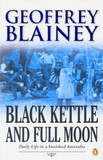Black Kettle and Full Moon: Daily Life in a Vanished Australia - SOLD OUT
Penguin
- SKU:
- PEN031
- Availability:
- SOLD OUT
Media: BOOK - paperback, 504 pages
Author: G. Blainey
Year: 2004
ISBN: 9780143002666
Other: b&w photos, sketches, bibliog, index
Publisher: Penguin
Used copy - good condition
This is history at its sparkling best interesting, enlightening, painstaking and objective. If you want to know about prime ministers and politicians, wars and class, economics and production, religion and sport, then look elsewhere. This is a book about people, ordinary Australians, and how they organised their daily life a long while ago.
It describes where they lived, how they shopped, what they ate and how they cooked it, what they drank and why. It tells us how they kept warm and cool, how they lit their houses, what they wore and where they bought it. It begins in the middle of the 19th century when there were less than half a million white Australians and ends with World War I when there were 5 million.
This was an era of plenty: in the 1880s, Australia probably had the highest standard of living in the world. It was an era of optimism and contentment. "Sail up Sydney Harbour, ride over a Queensland plain, watch the gathering of an Adelaide harvest, or mingle with the orderly crowd which throngs to a Melbourne Cup race," wrote the English-born novelist Marcus Clarke. "And deny, if you can, that there is here the making of a great nation."
Yet Australians of today, although they may have read about the broad historical and political trends of the period, do not know how their ancestors coped with life. Blainey himself became aware of how little even historians knew about the everyday when citizens who set up folk and regional museums asked him questions about candles, tobacco tins, matches, bottles, jars, jam-making, shoelaces and billy cans.
"I began to collect the evidence in this book long before I decided to write the book," he says. But where did he find the information? Sometimes living Australians could remember something a great-grandparent had told them. Newspapers of the period proved a gold mine. A report of a fire which destroyed a shop would list all its contents. Shipping notes listed cargoes, catalogues for trade fairs showed what was on sale, paintings revealed much, someone from a family of butchers would remember what was traditionally used in sausages as colouring and preservative.
So the book is fascinating in its detail and prepare to have a lot of your cherished beliefprejudices shattered. Garlic was in common use in Australia long before the first Italian and Greek immigrants arrived. Most Australian men did not drink beer but spirits, especially rum. The favourite drink of everyone was tea. It was taken black, sweet and piping hot and more was drunk in Australia than in all of continental Europe, far more than even the teeming population of India could down.
It was drunk morning, noon and night, with meals and in between. The meals were, of course, meat, meat and more meat. Before refrigeration there was no export market for meat so Australians had to eat the lot themselves. To know the full taste of meat was to be an Australian.
And not just beef and mutton. Butchers sold pig's trotters, tripe, kidneys, liver, brains and tongues, dripping and lard, flaps of mutton, sausages and saveloys and corned beef. And until state governments stepped in and passed protection laws, Australians also ate a wide variety of native birds, from swans to emus. Blainey writes: "Visitors were less surprised by the vote than by the meat. That every man could vote was interesting. That nearly every man and woman could eat meat at nearly every meal was astonishing."
Some parts of everyday life were more efficient than they are today. In Sydney in the 1880s, you could post a letter early in the morning and receive a reply before sunset. Blainey modestly admits that after three decades as a historian, some of his discoveries surprised even him.
You could have ice in your summer drinks but the ice was not from the local ice-works (they came later). It was cut from winter ponds near Boston and packed in straw brought as cargo on sailing ships to Australian ports.
And did you know that Australia had a distinctive odour? "We are near Australia," said sailors as the ship approached land at the end of one long voyage. "Can't you smell the flowers?" It was worth reading this excellent book just for that line. (Reviewed by Phillip Knightley, The Bulletin, Vol. 121 No. 43)
Contents:
Preface
Part 1: Oceean and Moon
1. Moon, Sun and Stars
2. The Dimming of Candlelight
3. Across the Seas
4. Letters, Cameras and that Magic Wire
5. Coo-ee, Bell and Silver Tongue
6. Gold Watched and Sovereigns
Part 2: The Black Kettle Sings
7. The Full Taste of Mean
8. Did Ever a Woman Eat More?
9. Potato and Sparrow
10. The Sparkle of Boston Ice
11. To Tipple and to Smoke
12. In that Black Billy Can
13. Restaurants and General Stores
14. On Pricing a Way a Life
Selected Sources
Index
Related Products

 AUD
AUD
 USD
USD
 NZD
NZD
 GBP
GBP
 Euro
Euro









